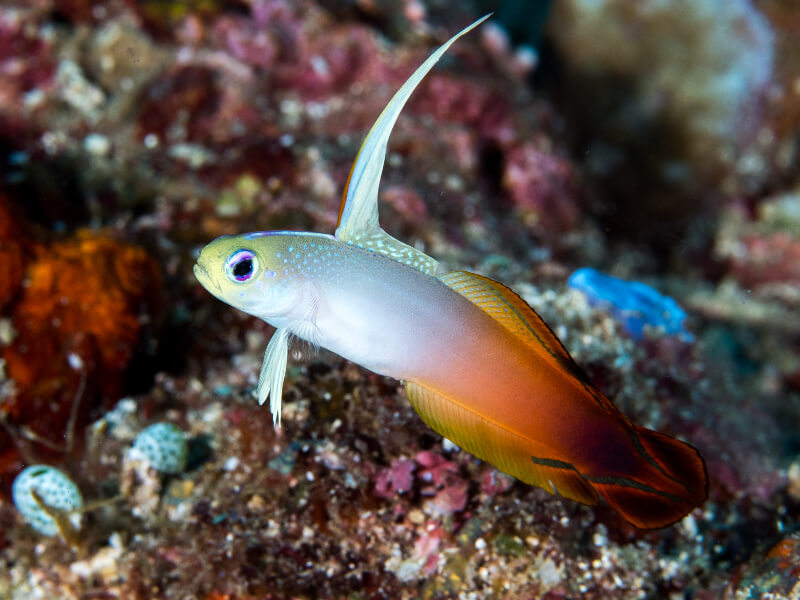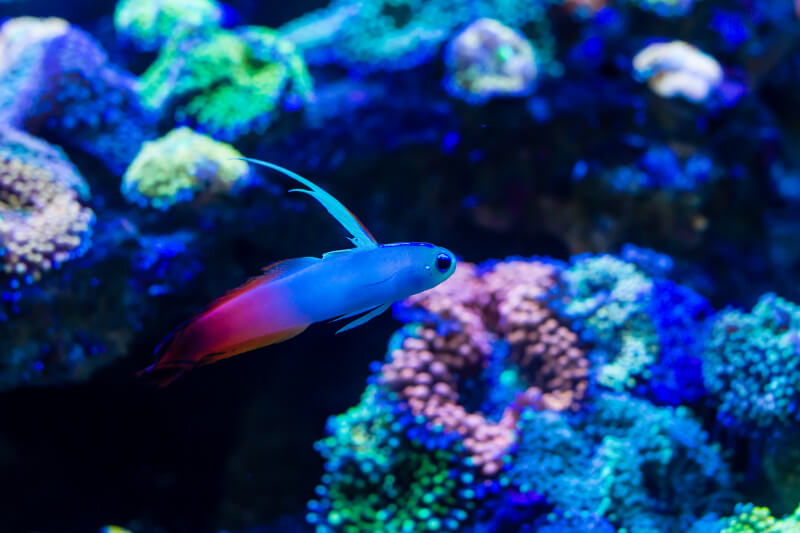Welcome to our comprehensive Firefish Goby care guide! The Firefish Goby, also known as the Fire Dartfish, is a small and colorful fish that can bring life and vibrancy to your marine aquarium. With its unique appearance and fascinating behavior, this goby is a favorite among many hobbyists.
In this guide, we will provide you with valuable insights into the Firefish Goby’s habitat, tank requirements, feeding habits, and compatibility with other tank mates. Whether you are a beginner or an experienced aquarist, we are here to help you create a thriving and enchanting underwater world for your Firefish Goby. Let’s begin!
Species Summary
The Firefish Goby, or Nemateleotris magnifica, is a hardy, peaceful fish that’s great for aquarium enthusiasts of all skill levels. Otherwise known as a fire goby or fire dartfish, these stunning fish are commonly found in the reefs of the Pacific and Indian oceans. They’re fortunately not endangered and are native to places like Hawaii, Austral Island and Eastern Africa.
These Gobies often hover right above the reef in depths ranging from around 20 feet to more than 200 feet. They’ll face the current and let their meals come to them rather than actively hunt. As juveniles, they’ll travel in small schools for safety. After reaching adulthood, they’ll prefer to live alone unless they form a mating pair.
Author Note: An interesting note is that the name “dartfish” comes from their sudden diving behavior when they feel scared or threatened. You may see your Firefish Goby swimming peacefully around your tank before it quickly darts under a rock or burrow.
This fish’s elongated dorsal fin is easy to spot along their back. They use this fin to signal danger to others as well as a “locking” behavior to wedge themselves into crevices so predators can’t reach them.
These Gobies get along well with other gentle saltwater fish and are hardy against most diseases. Caring for these gorgeous ornamental fish is typically straightforward by traditional aquarium standards.
Appearance
Firefish Gobies are long, slender fish with orange-red, yellow and white markings. The fish’s face is yellow followed by a creamy white midsection. Its posterior is a striking orange-red color.
This fish’s primary caudal, dorsal and anal fins are highlighted in black. The first spine is the dorsal fin, which can grow to be longer than the fish’s body. There aren’t that many gender differences between male and female Gobies other than the females tend to be slightly smaller and thinner.
Unlike other similar species, Firefish Gobies can’t change sex once they’ve matured.
Lifespan
With proper care and a secure tank, your Firefish Goby has an expected lifespan of up to three years. As these are skittish fish, it’s essential to keep their stress levels low and equip your aquarium with netting to avoid any fatal jumps.
Author Note: Be careful because many beginner aquarists often make the mistake of leaving the aquarium lid open, which could result in losing a Goby. Tank netting is a highly recommended security feature for this species.
Average Size
On average, an adult Firefish Goby can grow to a size of about 2 to 3 inches in length. While in their juvenile stage, they can seem like the perfect size for a nano tank. Given their energetic swimming style, however, it’s better to give them ample moving room.
Firefish Goby Care
Firefish Gobies are easy to care for and don’t require much special attention. They’re great additions to any reef aquarium.
It’s important to be careful with your chosen tank mates as aggressive companions could hurt these gentle fish. The size and security of your tank can also have a huge effect on your Goby’s lifespan.
Tank Size
It’s best to house your Firefish Goby in at least a medium-sized tank of 20 gallons. Bigger is always better with these fish as they are an incredibly active species. They require a large swimming area where they can freely display their darting behavior.
With smaller tanks, you run the risk of overcrowding, which can lead to aggressive clashes.
Water Parameters
Water temperature: 72°F to 80°F
pH levels: 8.1 to 8.4
Water hardness: 8 to 12 dGH
Specific gravity: 1.020 to 1.025
Tank Setup
Firefish Goby enjoy an environment with a medium to strong water flow. Keep your tank lighting set to low or moderate. Too much light can stress your Goby and prevent them from coming out to eat.
You should also make sure there’s a sizable clear area along the bottom of your tank where they can hover. In the wild, they stay right above the reef to feed. Gobies also like to dig into the substrate to hide, so be sure to use fine sand or smooth pebbles. If your substrate is too rough, it could scratch or damage their delicate fins.
Firefish Goby will often have a designated “hiding hole” where they can retreat and feel safe. Consider investing in a few cave-like structures that are safely reinforced to prevent crushing your Goby.
Author Note: Lava rocks and solid corals make for great homes for these charming fish. An easy DIY idea is to trim a piece of PVC pipe into a makeshift shelter. Cover it with a rocky facade to complete the look.
Are Firefish Gobys Reef-Safe?
Yes, Firefish Gobies are reef-safe and pose no risk to your reef aquarium. They’re generally docile and won’t nibble on or otherwise disturb your coral or anemones. They’ll also leave your invertebrates alone along with your feather duster worms, hermit crabs and brittle starfish.
Common Possible Diseases & Prevention
While naturally resistant to common diseases, Gobies can still develop saltwater ich or “white spot disease.” A saltwater ich outbreak can leave your fish susceptible to bacterial infections that spread rapidly throughout the tank.
The best way to prevent illness is to quarantine all new fish for at least a week to ensure they’re eating and swimming properly. There’s no need to preventatively treat these quarantined fish unless you know they’re sick. Unnecessary treatments can add to your fish’s stress and ultimately worsen their condition.
Author Note: Make sure to give your Goby the “spa treatment” since stress is one of the biggest determining factors in a fish’s health. It’s vital to maintain perfect water conditions, quality nutrition and plenty of places to hide to keep your fish happy and well.
Food & Diet
Firefish Gobies require an omnivorous diet mix of zooplankton and meaty pieces of live brine shrimp or mysis shrimp. To be more specific they are planktivores which means they feed on small organisms suspended in water. They have small guts, so it’s best to feed them two or three times a day.
Live food is naturally more nutritious, but it comes with the danger of potentially introducing harmful bacteria to the tank. Frozen shrimp is a safer alternative that ensures your Gobies still receive enough nutrition.
You can also use a combination of flake foods and marine pellets to guarantee a well-balanced diet.
Behavior & Temperament
These undemanding fish will spend much of the daytime toward the bottom of the tank. They love to burrow and search the substrate for any lingering bits of food. Firefish Gobies have a swim bladder that allows them to hover in place with their head pointed up.
Author Note: If at first you don’t see your Goby too often don’t worry, it’s not uncommon for them to hide away in the rocks when first introduced to a new tank. As long as you don’t see them surfing the substrate, you will be fine. They’ll start coming out more frequently once they feel secure.
Firefish Goby Tank Mates
As far as tank mates, Firefish Gobies are best placed in tanks with other small, non-aggressive fish. When bullied, they’re more likely to starve or accrue damage. Constantly losing fights can put so much stress on a Goby that it prematurely dies. In an ideal environment, Firefish Gobies can act as “dither fish.” Their playful behavior and swimming patterns will encourage other shy fish to come out of hiding more often.
You should avoid adding larger, more aggressive fish like Angelfish, Dottybacks or Groupers in with your Goby. Even semi-aggressive yellow tangs and blue tangs can be too much for the passive Firefish Goby to handle. Aggression issues can become much worse if your Gobies are added late to the tank.
While generally obedient and peaceful, Gobies will become territorial against others of their own kind. Unless you’re keeping your Gobies with the intent to breed, it’s typically best to only have one per tank. When considering tank mates, you should look for slow-moving, timid fish with mild manners.
Some great tank mate options for your Firefish Goby are:
- Pink Skunk Clownfish
- Shrimp Gobies
- Neon Gobies
- Engineer Gobies
- Royal Gramma
Author Note: Make sure to avoid predatory tank mates, like Lionfish, Groupers, and Moray Eels.

Breeding
One of the hardest parts of keeping Firefish Gobies is breeding them. It’s nearly impossible to tell their sexes apart, and they have a general intolerance for others of their species that can be hard to overcome.
You shouldn’t keep more than one Goby in a single tank unless you have the time and commitment to constantly monitor them. The resulting aggression and territoriality could quickly skyrocket their stress levels and harm their health.
Author Note: Those interested in breeding can instead try to adopt a pair that’s already bonded. If the two Gobies in your tank form a pair, it’s safe to assume they’re of different sexes. Even with a successful monogamous pair, Gobies don’t spawn frequently while in captivity.
Not much is known about the Firefish Gobies’ mating or egg-laying habits due to their shy nature. Like other Goby species, many assume they lay their eggs in the substrate or rock crevices not far from their hiding holes. Gobies won’t attack other fish or crustaceans who eat or damage their eggs, which can make the breeding process even more difficult.
To ensure your new Gobies reach maturity, keep a watch out for any egg clusters. Once you find them, it’s best to place them in a separate tank with a gentle sponge filter that won’t suck up the offspring after they’ve hatched
Wrapping Up
We hope this guide has given you a solid understanding of Firefish Goby care. By providing the right environment, proper nutrition, and suitable tank mates, you can ensure the well-being and happiness of your Firefish Goby.
Remember, this small but striking fish deserves a safe and comfortable home to thrive in. Take the time to observe its graceful movements and its ability to gracefully dart in and out of hiding places. With patience and dedication, you will be rewarded with the beauty and elegance of this mesmerizing species.
As always, if you have any further questions or need assistance, don’t hesitate to reach out to us and don’t forget to tag us on Facebook when posting about your Firefish Goby.
Please check out other care guides before you leave 🙂



